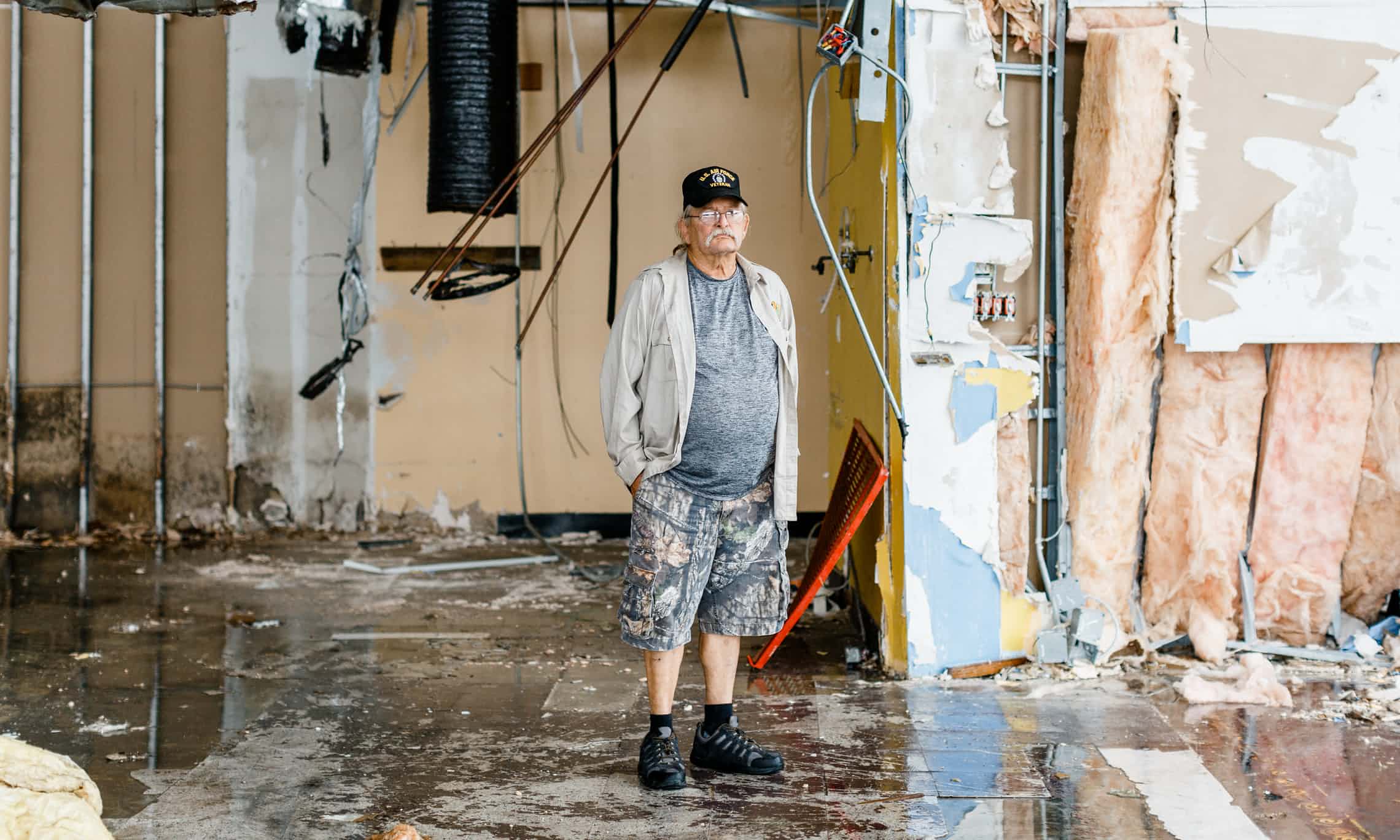The couple climbed to the attic of their rental home and tied themselves together with ripped-up sheets. As they lay down, Yoke steeled for the end and Zurawski clutched a marker pen, ready to scrawl her social security number on her arm to make it easier for rescuers to identify her body.
That was nearly six months ago. The present challenge, a mood of slow-burning frustration rather than a life-or-death adrenaline rush, can be summed up by the wads of documents they have crammed into a satchel. And the location of those dossiers: a small but cozy and well-appointed trailer near the beach where they live with two friendly black labradors.
Like several others in Port Aransas, it was provided not by the government but through Adapt A Vet, a small Texas organisation that helps military veterans and their families. “The non-profits have done a wonderful job for a lot of people but there’s so many more people in need. We need people to know what we’re still facing,” Zurawski said.
After the influx of volunteers and emergency workers and donations to meet urgent basic needs, many of Harvey’s victims have endured a time-consuming, energy-sapping bureaucratic labyrinth: exacting rules, hours on hold to call centres, waits for site visits, more questions than answers and the anxiety that help will be curtailed even though a return to something that resembles normal life is still months or years away.
“Our government has failed us,” said Zurawski, 48. “It’s really sad that we’ve been overlooked and forgotten. Our mayor has done what he can as well as our city manager. We started out strong … and as time went by things changed.”
Like many small island communities, Port Aransas feels at once wide open and insular: before the storm the population was only 3,800, yet it welcomed about 5 million visitors a year. Reached by ferry or a causeway from Corpus Christi, the place would normally be at its most freewheeling next month, crammed with spring breakers.
The beach is in excellent shape but many condos and hotels are still under repair and only about half the restaurants and bars are open. On a chilly and grey day last week, building contractors seemed to outnumber tourists. Ten or so men worked on the roof of a gift shop whose boarded-up entrance is shaped like a giant shark’s mouth.
Harvey made landfall late on 25 August last year as a category 4 storm: the first hurricane of that magnitude to reach the US for 13 years and the most powerful to strike Texas since 1961.
Downgraded before long to a tropical storm, it stalled and dumped record rainfall over Houston, causing catastrophic flooding in a metropolitan area of about seven million people. Houston’s soaking understandably drew most of the media and political gaze, but the coast was battered not only by rain but also wind and storm surge.
While the disaster in Houston was epic in scale, the proportion of damaged structures was far higher in Port Aransas, where 85-90% of buildings were touched.
“First ones hit, first ones forgotten,” said the mayor, Charles Bujan, who estimates the city sustained at least $700m in damage – a huge sum in a place where many residents work low-paid jobs in the tourist industry. Bujan said that between 100 and 150 unrepairable homes are either demolished or need to be: “Now we have a gigantic housing crisis.”
He rates Fema’s performance as mixed. “Good job on debris removal and they have been very helpful to people that needed rental assistance, but when it comes to fulfilling their mission to provide housing on an 18-month basis, they are a dismal failure,” he said.
Fema moved dozens of mobile homes to a field 65 miles from Port Aransas last year.
But only a handful have been installed in the town. As of 7 February, according to the agency, eight applicants are housed out of 29 eligible, while 96 households are in Fema-funded hotels.
“The use of manufactured housing units and travel trailers is an option of last resort. In this disaster, fewer than 2% of survivors approved for federal aid (370,000) were eligible for direct housing (6,600). Units are staged for hauling and installing as needed,” a Fema spokesman said.
Temporary housing became a symbol of the botched response to Hurricane Katrina, with lawsuits alleging that “toxic trailers” exposed thousands of people to dangerous levels of formaldehyde.
Bujan suspects that the agency’s previous problems led it to set the bar for eligibility so high that few would qualify. “They came here wanting to find some reason not to provide mobile homes. Instead of coming here with the intent on helping satisfy a need, they came here with the intent of finding a reason to deny it,” he said.
The six-month point since Harvey struck is not only a symbolic marker. An eligibility review for those in Fema’s Transitional Shelter Assistance programme is set for 20 February, leaving some survivors wondering what the future holds. A trailer? An extended hotel stay? Or a cutoff?
“It’s a monster mess,” said Mary Salg, manager of the Shark Reef Resort, where many families sheltered by Fema have stayed. “I know one person that got a trailer, one, and I’ve had 106 families come through my door.” Some are worried that future aid will be contingent on relocating to Corpus Christi, she said, and they fear that once they have left the island they will never return.
Annetta Adams runs a vacation rental and guide fishing business with her husband, James. As well as navigating the vagaries of private insurance claims and repairing the ground floor of their turquoise-coloured house, where the water level reached 56in, they are taking care of Bubba, her father.
“Right from the get-go I talked to Fema about getting housing for him, to get a trailer for him, and they were like, ‘Oh, well yeah, we can help with temporary housing, we can send him to Corpus.’ I’m like, ‘Yeah, and how’s that going to work?’ He’s 98, he doesn’t drive,” she said.
Two site surveyors arrived in the first week of October, she said, but they planned to set up a 14ft by 65ft trailer that was too big for the plot and for a single elderly man. Then everything went quiet until last week, when a representative from the general land office – the state agency that is working with Fema on housing – got in touch to discuss installation.
Russell Edge’s stubborn chihuahua survived when the storm struck, but the 65-year-old lost almost everything else. “I did get help from Fema but it was just the basics. I got about $3,000; that was for rent and personal property,” Edge said.
He plays guitar at a pirate-themed bar and pays $400 a month in rent for a trailer supplied by Adapt A Vet. Fema, he said, “knew my home was totalled, they knew my home was unlivable, but they have yet to reach out and say ‘we have something’.”
Despite everything, sipping a drink in a bright and smartly-restored coffee house, Edge sounded optimistic about the future of Port Aransas and its people.
“I was raised all my life – Southern Baptist – that the good Lord will never put you through more than you can handle,” he said.







